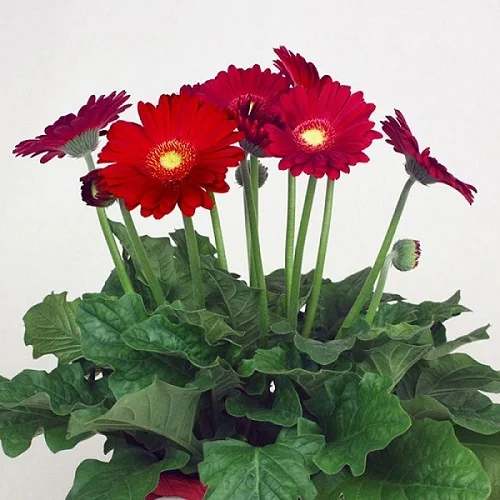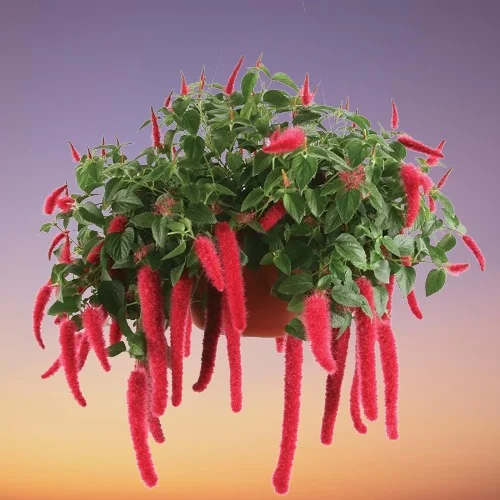11 Reasons Why Gerbera Daisy is Not Blooming and How to Promote Flowering
Some links in this post may be affiliate links
Gerbera Daisy is not blooming due to too little light, inconsistent watering, improper feeding, temperature stress, low humidity, lack of pruning, poor soil quality, pests infestations, root-rot among others.
Gerbera Daisy is considered to be one of the popular flowering plants for the well-lit spaces in the home.
To keep Gerbera Daisy blooming give it bright light with 6-8 hours of direct sunlight, warmth of 15-250C, humidity of 50-55% and moderately moist, rich, well-drained soil coupled with monthly feeding in the growing season. Learn how to grow and care for Gerbera jamesonii indoors.
If not given the right growing conditions, Gerbera Daisy will not flower. Below are 11 reasons why your Gerbera Daisy is not blooming and how to encourage it to flower.
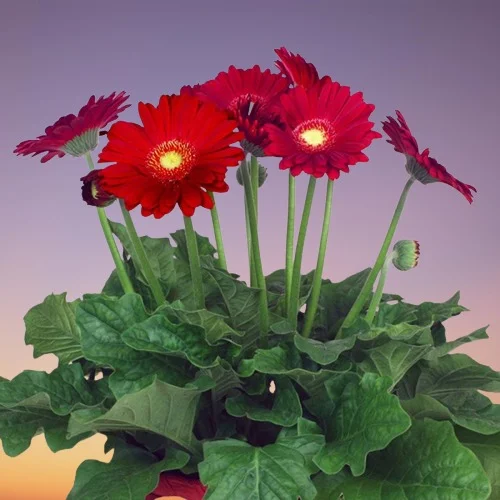
11 Reasons Gerbera Daisy is Not Flowering with Remedies
1. Too little light
Enough light is necessary for the plant to make food needed for growth and energy. If the light is too low, the plant will not make adequate food for growth and development which results in reduced growth and lack of blooms.
How to fix itPosition your Gerbera Daisy to infront of a brightly-lit window where it will receive bright light with 6-8 hours of morning or late afternoon sunshine. If the natural lighting is not adequate, consider instaling a grow light because sufficient light is critical for flowering.
Regularly rotate the pot to ensure that the plant receives light on all sides for even growth as well as prevent lopsided growth.
2. Lack of pruning
Pruning is an important practice for Gerbera Daisy to keep it neat, discourage pests and diseases and to encourage blooming. Left unpruned the flowers will be drastically reduced.
How to fix itRemove yellow and dead leaves to keep your Gerbera Daisy neat as well as minimize pests and diseases infestations.
With a sharp, sterilized pair of pruning scissors, cut the flower stalks at the base when the flower is spent. This will also encourage production on more blooms.
3. Improper feeding
Underfeeding your Gerbera Daisy means that the plant is not getting enough nutrients needed for growth, therefore, the plant will not bloom.
If you overfeed the plant, the roots will die due to fertilizer burn. When the roots die, they cannot take up nutrients and water required for photosynthesis, thus the plant will not flower and may begin to die.
How to fix itFeed your Gerbera Daisy every 3-4 weeks during the growing season with a phosphorous-rich, water-soluble fertilizer to encourage blooming. Ensure to follow the maufacturer's instructions.
Withhold feeding in the cold season as growth is minimal and feeding at this time can lead to fertilizer burn and death of the plant.
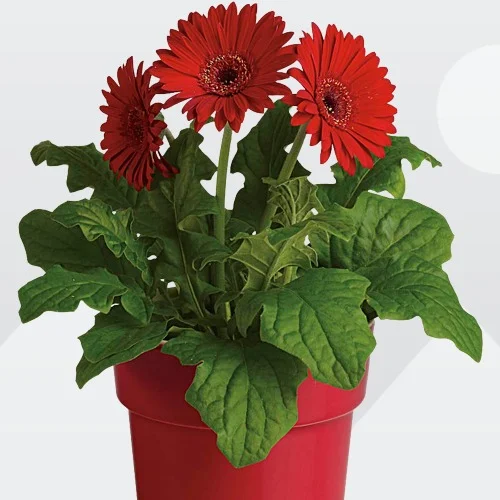
4. Poor quality soil
Poor quality soil that does not drain freely will easily become compacted or soggy which will lead to reduced growth and poor flowering.
How to fix itGrow your Gerbera Daisy in fertile, free-draining soils to prevent waterlogging while providing the required nutrients. A blend of 3 parts multipurpose potting mix amended with 1 part sand is ideal for this plant.
5. Pest infestations
Gerbera Daisy is prone to scale insects, spidermites, aphids, fungus gnats and caterpillars. These sap-sucking insects will cause the plant to be dehydrated resulting in stunted growth and reduced blooming.
How to fix itEnsure that your Gerbera Daisy is healthy at all times by providing the right growing conditions.
To minimize pest infestations raise the humidity as these pests are attracted to dry growing conditions.
Keep the plant well pruned by removing spent flowers, dead and yellow foliage to reduce infestations by these pesky insects.
Regularly inspect the plant for these pests and take timely control measures. If the plant is infested, isolate it to minimize spread to other plants.
Treat the afftected plant with insecticidal soap or neem oil. Be careful to follow the manufacturers' instructions.
6. Root-rot disease
Gerbera Daisy is prone to root-rot disease which is prevalent in soggy soil. The disease is characterized by yellowing, wilting and leaf drop which will result in reduced flowering and eventual death of the plant if not treated.
How to fix itCarefully, slip the plant out of its pot and inspect the roots. Any brown-black, mushy roots indicate root-rot, trim them off.
Treat the healthy roots with a copper-based fungicidal solution as recommended by the manufacturer.
To reduce, re-infection, disinfect the pot with the fungicidal solution or use a fresh pot and repot the plant in fresh well-drained soil.
Do not water the plant immediately, keep it dry for about 7 days before you resume watering.
To avoid root-rot in the future, always make sure that the pot has a drainage hole and that the soil is free-draining so that it does not get soggy.
Take care not to overwater the plant especially in the cold season as growth is minimal at this time and the plant does not need a lot of water.
7. Being extremely pot-bound
Gerbera Daisy flowers best when slightly pot-bound but when it is extremely pot-bound it will wilt, droop and may die due to reduced growth.
This is because the roots have filled the pot and there is very little soil to hold water when you water your plant. If there is too little water in the soil for the plant to take up to the leaves for photosynthesis, the plant cannot make adequate food for growth and blooming.
How to fix itIf you note a lot of roots growing through the drainage hole, repot your Gerbera Daisy into a pot one size larger than the current one.
Thereafter, repot at the beginning of the growing season when it has become extremely pot-bound. Ensure that the pot has a drainage hole and that the soil is free-draining. Check out these pots with drainage holes on Amazon.
You may also divide the plant into several sections to propagate new plants
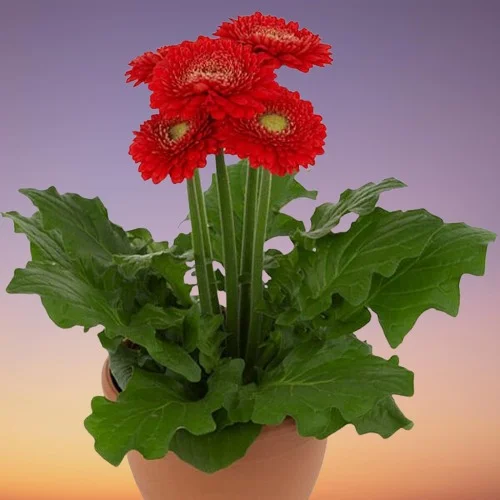
8. Low humidity
If the air humidity is too low, it may result in brown leaf tips and edges, reduced growth and lack of blooms.
How to fix itGerbera Daisy prefers a humidity of 50-55%. To raise humidity, set the pot on a wet pebble tray, use a cool mist humidifier or group the plants together.
9. Temperature stress
Gerbera Daisy flourishes in Extreme temperatures will cause stunted growth and reduced flowering. Low temperature lead to reduced growth and by extension reduced blooming. Too hot temperatures will cause the plant to become dehydrated resulting in lack of blooms if not corrected.
How to fix itKeep your Gerbera Daisy away from drafts coming from windy windows and doors, air conditioning units, hot surfaces, heating units, hot stoves and others. Maintain a warmth of 15-250C.
10. Inconsistent watering
Underwatering implies that there is too little moisture in the soil for your Gerbera Daisy. Water is needed by the plant for photosynthesis to make food for growth and blooming.
Overwatering causes the soil to become soggy which leads to the death of the roots due to lack of oxygen. When the roots die, your Gerbera Daisy cannot take up water and therefore it cannot make the food needed for growth and flowering.
How to fix itDo not water on a schedule to avoid either underwatering or overwatering. Water your Gerbera Daisy when the top 2-3 inches of soil dry out but do not allow the soil to dry out completely for prolonged periods of time.
11. Salts buildup
Accumulation of salts and chemicals originating from water and fertilizers will cause the roots to die. Therefore, the plant cannot take up water and nutrients to the leaves for food making. This will lead to reduced growth and blooming.
How to fix itOccasionally, flush out accumulated salts by running a stream of water through the soil until it comes out through the drainage hole. Allow the stream of water to run for some time and repeat the process several times.
You liked it? Share on social media.
Related Content
Amazon Associates Disclosure
Homeplantsguide.com is a participant in the Amazon Services LLC Associates Program, an affiliate advertising program designed to provide a means for sites to earn advertising fees by advertising and linking to amazon.com.



